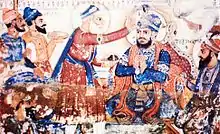Baba Buddha
Baba Buddha (6 October 1506 – 8 September 1631)[1] was a prime figure in early Sikhism. He was born in 1506 in the village of Kathu Nangal, in Amritsar. As a child, while grazing cattle outside his village, he met Guru Nanak. He asked Guru Nanak many questions regarding life and death, such that, at his young age,Guru Nanak blessed him with the name Buddha, as he spoke as if he were a wise elder. He was one of the earliest Sikhs of Guru Nanak, and performed the formal coronation ceremonies of the five Sikh gurus who succeeded Guru Nanak; Guru Angad, Guru Amar Das, Guru Ram Das, Guru Arjan, and Guru Hargobind. [2][3]
Baba Buddha | |
|---|---|
 Baba Buddha crowning the fifth guru | |
| Born | 6 October 1506 Amritsar, India |
| Died | 8 September 1631 (aged 124) Ramdas Village |
| Years active | 1506-1631 |
| Known for | Early figure of Sikhism |
| Parent(s) | Bhai Sukha Randhawa, Mai Gauran |
| Part of a series on |
| Sikhism |
|---|
 |
On installation of the Adi Granth, a compilation of Sikh scripture, at Sri Harimandir Sahib on August 16th, 1604, Bhai Buddha was appointed the first Granthi by Guru Arjan.
On May 30th, 1606 [1] after the martyrdom of Guru Arjun, Guru Hargobind ordered the construction of the Akal Takht and entrusted the responsibility of its construction to Baba Buddha and Bhai Gurdas.
After a lifetime of following the Sikh Gurus, Baba Buddha died at the age of 124 years in 1631 at the village of Jhanda Ramdas, on the banks of the Ravi River. Guru Hargobind was at his bedside and honoured him by carrying him to his funeral pyre and reciting passages from the Adi Granth.
References
- "BUḌḌHĀ BĀBĀ (1506-1631)". eos.learnpunjabi.org. Retrieved 2019-08-29.
- Singha, H. S. (2000). The Encyclopedia of Sikhism (over 1000 Entries). Hemkunt Press. ISBN 9788170103011.
- Khalsa, Gurutej Singh (2014-08-23). Rajni. Trafford Publishing. ISBN 9781490743301.
- gurbilas Chhevin Patshahi. Patiala, 1970
- Bhalla, Sarup Das, Mahima Prakash. Patiala, 1971
- Padam, Piara Singh, and Gianl Garja Singh, eds., Guru ban Sakhlari Patiala, 1986